
oudistcamp - 6-11-2012 at 05:46 PM
Recently, I witnessed cooking vegetable oil applied liberally on an oud face as a finish. Is anyone familiar with that practise?
The soundboard did not feel greasy after the application, and the oud actually sounded better to me.....
Just curious....
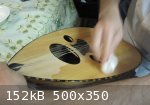
fernandraynaud - 6-12-2012 at 12:14 AM
There are countless bad ideas in circulation. This is one of them. It may not cause a dramatic or immediate devastation in all instances, but anything
that penetrates and is not going to dry "brittle" tends to dampen the resonance of a soundboard. Think slice of bologna.
I heard about a number of harpsichords whose owners had used oil on the case/body to good effect, so they merrily kept going and applied oil on the
soundboard. The one I heard most about lost all its sparkle, and it took over 2 years to clean it back to health. Same with an oud. Shellac is the
only known safe finish on a soundboard. The goopy varnishes that are often slathered on cheap ouds can usually be sanded/steel-wooled down to a thin
layer. It really opens up the instrument (like having that slice of bologna removed). Oil is harder to deal with. Cooking oil and butter are not much
of a "finish", either. It does look nice until it turns rancid and attracts vermin ;-)
jdowning - 6-12-2012 at 06:15 AM
To add to fernandraynaud's observations - any fluids like oil or fats that are readily absorbed into a sound board will increase the internal damping
of the wood (ie reduce the resonance characteristics) as well as increase the density of the wood. A relative increase in density results in a
reduction in the 'Sound Radiation Coefficient' - considered to be a bad thing among luthiers.
However, some contend that an increase in internal damping - within limits - may not be a bad thing as it might result in a more even distribution of
the many sound board resonant frequencies giving the instrument a different 'tone colour' and a more uniform sound (less emphasis on certain
frequencies that sound louder than the rest). If this is the case (and research has yet to confirm it) then it is quite possible that oudistcamp did
notice changes in the sound of the oud that he judged to be an improvement.
An interesting article about this can be found on the website of Liutaio Mottola entitled "Damping is Bad?"
http://liutaiomottola.com
Under 'Major Areas on this Site" go to"Technical Information for Instrument Designers" then "Technical Design Information" then "Lutherie
Myth/Science" and scroll down to the article "Damping is Bad?"
There are many other interesting luthier topics as well on this site.
Note that in the Turkish oud making tradition sound boards are left without a finish as any kind of finish - particularly oil or grease - is
considered to be detrimental to the acoustic performance.
fernandraynaud - 6-12-2012 at 03:45 PM
There's no question that a slice of bologna has a very even distribution of resonant frequencies, but the one obvious shortcoming is the lack of
volume. Ouds that have the proverbial varnish sanded down sound louder, clearer. Rather than try to help out with damping, I'd just let the wood work
it out. There's a lot to be said for the unfinished soundboard. Shellac doesn't seem to have any noticeable impact on sound, so it's not like there
are no options available if you want to protect the soundboard from stains. If you aren't good at French Polishing (it's a specific way to apply
shellac in a very thin coat), brushing on some shellac (in alcohol) and sanding/steel-wooling it to the finish you want works quite well.
Franck - 6-13-2012 at 06:14 AM
In my experience, lacquer is also good if applied thinly.
jdowning - 6-13-2012 at 06:29 AM
I can't imagine that luthier Mottola would ever advocate applying a vegetable cooking oil to a sound board in order to modify the damping
characteristics and neither would I.
What has aroused my curiosity here is that oudistcamp thought that he heard an improvement in the sound of the oud after vegetable cooking oil was
liberally applied to the sound board - contrary to what might be expected. Of course subjective 'before and after' assessment of sound is unreliable
as proof that there has been any improvement at all - what is needed is some means to measure any change in the wood's acoustic properties for
comparison.
I assume that the oil under consideration here is a vegetable oil that is non drying on exposure to air - such as Olive or Almond oil as opposed to
those vegetable oils that do dry (eventually) on exposure to air - such as Linseed, Tung and Walnut oils (all used for wood finishing).
As I have been recently testing sound board wood samples acoustically in order to compare their relative 'goodness' as tonewoods, I thought that it
might be interesting to use this method (speed of sound resonance method) to try to find out if the application of a non drying vegetable oil to the
upper surface of Sitka spruce samples - cut longitudinal to the grain and cross grain (radial) - results in any measurable change to the acoustic
properties. I shall report the results of these tests later on this thread. Should be interesting.
No plans to carry out acoustic trials on Italian sausages though!
oudistcamp - 6-13-2012 at 06:56 AM
Very interesting indeed. Thank you for the info and viewpoints.
Thank goodness the oud in the photo is not one of mine.....
It was corn oil that was used here.
The oud sounded good after. I have to visit it in a couple of months for another look and try.
Bologna is best eaten, not played, with or without a risha..
May make a good pickguard, tho.
DoggerelPundit - 6-13-2012 at 09:43 AM
Corn oil eh? It must be one of those high fiber, low trans fat sound boards I've been hearing about.
For me, I'll use an oud, with a plain unvarnished face, to sing the praises of olive oil, together with lemon juice, Bulgarian feta, garlic, mint,
oregano, dill, salt & pepper on chopped tomato, cucumber, green pepper, and red onion.
Oiled ouds with bologna pick guards. I never sausage an idea, but I suppose it's far from the wurst. 
-Stephen
jdowning - 6-13-2012 at 12:06 PM
For the acoustic trials I shall use Almond oil (because I already have some to hand) - otherwise it would be Olive oil - both appropriate in a Middle
Eastern context. Also both oils already have a long standing musical connection in that they were and still are used for oiling gut strings to impart
flexibility and extend the life of a string.
Almond oil is the least 'greasy' of the non drying vegetable oils. Sweet Almond oil is edible unlike the Bitter Almond variety that naturally contains
cyanide so best not to mess with it.
Checking out the many benefits claimed for Almond oil - not only is it a good food but is also a popular skin softener and, rubbed into the hair,
makes it long strong and thick.
Best of all, "regular consumption of the oil helps reduce cholesterol, nourishes the brain and nervous system, enhances intellectuality and endurance
and when applied provides relief to strained muscles" What more could an oud player ever want!!
As for the oud - well that may turn out to be another matter!
fernandraynaud - 6-13-2012 at 01:05 PM
I knew it .... that man is DANGEROUS! Anybody heard that red violins required the blood of not one but twelve little boys, and that the soundpost was
made of the stalk of the hyper endangered Chinese Moondragon Lilly (hint: there was one plant, under guard, at the Peoples' Botanical Garden in
Shanghai, but the guards made matches out of it and sold them. The only remaining one now, should you decide to accept it, is in the Beijing Forbidden
City's Hermes shop.) Now if we can just provoke John into actually TESTING bologna on a soundboard ...
jdowning - 6-14-2012 at 04:16 AM
Well that is exactly what I intend to investigate - to try to find out how much of this talk about the effect of oil on sound boards is pure 'baloney'
(or not).
Dangerous stuff indeed!
DoggerelPundit - 6-14-2012 at 06:37 AM
jdowning,
Oil migration in porous materials being what it is, would it be also worth checking for any short or long effects on hide glue joins? I'm thinking
where soundboard meets brace.
-Stephen
jdowning - 6-14-2012 at 05:13 PM
But how porous is a typical sound board wood to an oil finish?
Never having applied an oil finish to a soundboard I tested a quarter sawn sample of Sitka spruce that was 2.6 mm thick with a coating of Almond oil.
The oil was applied liberally to one surface and allowed to 'soak in' for 12 hours before the surface was then wiped clean of the surplus oil
remaining.
The oil darkened the surface as expected but there was no visual evidence of any oil having penetrated the full thickness of the sample.
The sample was then sectioned and examined under high magnification. Again there was no evidence that the oil had penetrated no more than about 0.1 to
0.15 mm below the surface as the attached images reveal. A non oiled sample is shown for comparison.
In practice when applying a rubbed vegetable drying oil finish (like TruOil or Danish oil) to hardwoods, the oil is rubbed in and allowed to remain on
the surface for about 10 minutes before being wiped off - so the above penetration test is more severe than would be experienced in normal
practice.
Although attempting to glue a brace to an oiled surface using hot hide glue would likely not be very successful (although I have never tried it) - on
the basis of this test there would appear to be little chance of any non drying oil finish soaking through the full thickness of a sound board to
cause problems with the security of the braces.
This perhaps surprising lack of penetration of a non drying oil on the sound board wood sample in turn suggests that the acoustic effect of the oil
(due to internal damping) may also be minimal.
This idea will next be examined by acoustic testing a spruce sample - longitudinal to the grain - before and after applying oil to one surface.
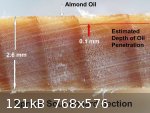
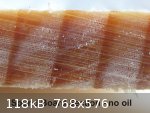
DoggerelPundit - 6-14-2012 at 08:08 PM
Well, this appears to settle the "brace side" question. Bless your resourceful thoroughosity.
♫ ♫ ♪
-Stephen
fernandraynaud - 6-14-2012 at 09:32 PM
I dunno, if the soundboard is composed of several pieces, there's also an opportunity for oil to work into any cracks. I'm not about to oil any
soundboards. A crunchy dry soundboard is what appeals to me. Even so-called "oil" finishes, like "tung oil", are actually a blend of polymerizing oils
and varnishes, and within minutes of being exposed to air they start to set, and lose any "oiliness" they may have.
oudistcamp - 6-15-2012 at 01:56 AM
That oil test is amazing! Thank you for the awesome nerdiness!!!
Makes me wonder if oil seals more than penetrates, and vice versa for water. Similar to how a moisturizer works on the skin.
Can't wait for the sound test.... 
jdowning - 6-15-2012 at 05:34 AM
I should point out that due to a miscalculation the depth of oil penetration previously posted should read 0.3 mm not 1 to 1.5 mm. The line drawn on
the image to indicate depth of penetration is to the correct scale proportionally. Estimation of the penetration depth is complicated because the un
oiled wood has some degree of translucency (as seen in the image of the section without oil) making the depth of penetration seem deeper than it
actually is due to the top lighting of the image. However, the oiled section has now been examined under a high power microscope with much better
resolution than the digital camera images to confirm that the depth of oil penetration is only about 10 early wood cells deep - that is no more than
0.3 mm as previously estimated.
I suspect that the degree of penetration is not time related so that there will be the same depth of penetration regardless of whether the surplus oil
is wiped of the surface of the wood after 5 minutes or after 12 hours or more. There may be some inter reaction of the oil with the wood cells that
limits penetration but I do not know what it might be.
It is common practice for woodwind instrument players to wipe the bore of their hardwood clarinets, oboes etc with almond or other non drying oils -
supposedly to limit moisture ingress and prevent cracking due to the wood drying out. However one commentator on this practice claims that the oils
are a poor barrier to water vapour and that the oils only combine with the lignin 'glue' surrounding the wood cell but with a weak bond - not the
cellulose of the cell walls that are apparently 'oil proof'.
I doubt if any oil somehow coming into contact with a cured hide glue joint - particularly if the oil seepage was very localised (through a crack) -
would be able to break the very strong, molecular level, bond between the glue and wood or if vegetable oil is capable of softening hide glue. But
that idea would have to be tested for confirmation.
So it would appear that a non drying vegetable oil might not be an effective moisture barrier (at a molecular level ) but might help save the day if
water was accidentally splashed on a sound board. I currently have a drop of water sitting on the oiled surface of the test sample just to see how
waterproof it is - no point in speculating.
Also the oiled test sample does not feel oily to the touch but I suspect that such a non hardening finish would attract quite a bit of dirt over
time.
jdowning - 6-15-2012 at 12:19 PM
Well, here is some food for thought.
The drop of water on the surface of the oiled test piece was fully absorbed into the wood within 20 minutes spreading along and across the grain and
apparently removing the oil in the process - see the attached image.
Microscopic examination of a section of the sample revealed what appeared to be a white translucent crystal or jelly like material filling the larger
early wood cells spreading to almost the full depth of the test piece.
It would seem that the water has reacted in some way with the oil to form some kind of emulsion (?) that has drained freely through the early wood
cells (but not the smaller late wood cells). Either that or the oil had in fact initially and invisibly soaked through the full depth of the test
piece and had reacted with the water as it too drained through the sample?
Curious - but it would seem from this that non drying vegetable oil does not protect against moisture ingress.
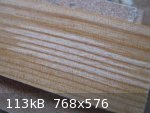
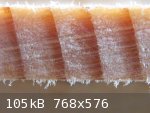
jdowning - 6-16-2012 at 12:26 PM
So, moving on to acoustic testing.
The sample chosen for the comparative tests is a piece of fine, straight grained spruce of construction grade - a bit 'heavy' so not quite good
enough for selection as sound board material. The sample has been prepared by reducing in thickness a test piece from another trial - dimensions 39.9
cm x 17 mm x 2.5 mm, grain vertical across the minimum dimension to represent a quarter sawn soundboard. Density of the sample is 514 kg/m³.
The sample was first acoustically tested free of oil and then after Almond oil had been applied to the upper surface of the sample. The oil was
liberally applied to the surface and then - after 10 minutes - surplus oil was wiped off. The sample was then set aside for 16 hours to reach
equilibrium conditions.
The attached images - for comparison - show the Audacity spectrum analyses and waveforms for the no oil and oiled acoustic tests.
The spectrum graphs show clear harmonic peaks of the fundamental, second, third and fourth harmonics from which the average speed of sound is 5378 m/s
- within 0.5% for both oiled and non oiled tests.
This translates into an acoustic Sound Radiation Coefficient - a standard measure of sound board material 'goodness' - of R = 10.5 for both the oiled
and non oiled samples.
So - no change due to oiling.
What about internal vibration damping?
From the waveform - amplitude against time - it is possible to make an approximate estimate of the loss factor which represents the level of internal
damping.
Again there is no significant difference between the oiled and non oiled samples.




fernandraynaud - 6-16-2012 at 05:03 PM
It doesn't seem like your almond oil is penetrating, so it's not too surprising it doesn't do anything, in any department.
jdowning - 6-17-2012 at 10:24 AM
Yes that is the anticipated result - oil penetration being limited by the time duration surplus oil remains on the surface before being wiped off - in
this case after 10 minutes.
To see if a longer time duration makes any difference, for test #2 the sample was flooded with oil on the upper surface and left for 24 hours before
being wiped off. It was noticed that oil had partly covered the underside of the sample but it is not clear if this is due to deeper penetration of
the oil through the sample or due to oil running over the ends and sides of the sample and then spreading over the underside by capillary action.
Therefore, to test for oil penetration a small plate of quarter sawn Sitka Spruce sound board material - planed smooth both sides - 4 mm thick has
been prepared. A small reservoir for the oil made from modelling clay has been made on the upper surface of the plate. This will be left filled with
oil to determine how long it will take for the oil to penetrate to the other side of the plate (if it ever does). After 3 hours it can be seen from
the attached image that oil is spreading essentially along the longitudinal wood cells. This mechanism suggests that the oil observed on the underside
of the sample in test #2 is a result of surplus oil running over the edges of the sample.
Non drying oil spreading in this manner might have implications for future repairs to a fixed bridge due to contamination of the wood under the bridge
- causing problems if a bridge had to be reglued at any time? This potential problem would not, of course, apply to a floating bridge design.
The #2 acoustic tests revealed a 2% drop in the speed of sound calculated from the resonant peaks - average value 5281 m/s compared to 5385 m/s for
the un-oiled case reducing the sound radiation coefficient to 10.27 or about 2% reduction. There was no measurable change in density of the sample.
Estimating the loss factor from the waveform gave a value of 0.0144 or an increase of about 11% compared to the un-oiled case.
These results would be consistent with a greater depth of penetration of the oil over a 24 hour period. Note, however, that it is very unlikely (I
would hope!) that oil would ever be applied in this manner.
The acoustic test will be repeated tomorrow without further oil coating (test #3) to see if there has been any change after a further 24 hours.
Finally test#4 will be to apply drops of water along the length of the sample followed by an acoustic test after the water has been absorbed - just to
see what happens. If there is a crystal or jelly like build up within the early wood cells as previously reported then it is possible that there may
be a significant reduction in velocity of sound, sound radiation coefficient and loss factor. If so, water molecules penetrating a non drying oil
finish from the atmosphere, at times of high relative humidity, may have a possibly permanent adverse effect on the acoustic performance of a sound
board.
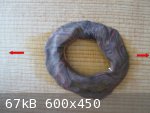
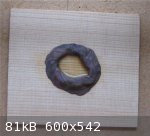


jdowning - 6-17-2012 at 12:10 PM
The reported 'mysterious' crystal or jelly like deposits in the wood cells would appear to be a non event.
The wood sections observed under a microscope at X165 magnification for both untreated Sitka spruce and spruce treated with oil and then water are
prepared by slicing the end grain of samples with a razor blade to produce a clean cut of the wood cells in section. This is a pretty rough and ready
method that should be done with a 'microtome' apparatus for perfect results - but they are pretty costly and I do not have one.
Using a Canon PowerShot A470 digital camera set to X1 macro mode with the lens hand held against the microscope eyepiece I was able to record somewhat
imperfect but otherwise reasonable images of the wood cell structure for both the untreated and oil + water samples - see attached images.
In both cases the 'mysterious' deposits are in evidence so they are likely nothing to do with mixing water with the oil finish. They are, in fact,
probably just accumulated crushed cells caused by the rough specimen preparation method of free hand slicing with a razor blade!
This being the case there should be no significant effect of the addition of water on top of the oiled finish for test #4 - but the trial will be
carried out just to see.
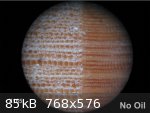
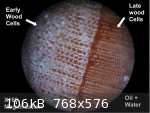
jdowning - 6-18-2012 at 06:35 AM
After 24 hours the oil in the saturation test has spread longitudinally across the full width of the test piece and is now flowing into the end grain
and is just starting to spread along the longitudinal cells on the other side. The lateral spread of the oil is much less confirming that the oil is
primarily conducted along the longitudinal cells close to the surface. There is no sign of oil soaking through the thickness of the test piece.
In the meantime, test #3 after 24 hours showed no change in the results previously obtained in test #2. This test piece will now be fully saturated
with oil (as far as possible - by soaking both sides over the next day or two and wrapping the piece in plastic) and then audio tested to represent
the worst case scenario.
The solubility of hide glue in Almond oil has been tried by immersing some dry 'pearl' glue in oil for 24 hours. As expected there was no softening of
the glue. So it can be expected that hide glue will act as a barrier against spread of oil across a joint but likely would not prevent the spread of
oil through the underlying wood cells. However that assumption would need to be tested.
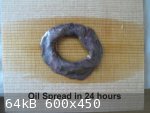
jdowning - 6-19-2012 at 10:01 AM
After 48 hours the clay reservoir on the saturation test piece has been removed. From the attached image it can be seen that the oil has spread
uniformly along the longitudinal grain - but with little lateral spread across the grain - and is seeping into the end grain partially spreading on
the underside of the test piece.
The test piece has been sectioned through the reservoir location in order to determine the approximate depth of penetration of the oil - estimated to
be about 0.5 to 0.6 mm. (see attached macro image). This does not represent a practical example of oil application where there would, of course, be no
reservoir feeding a continuous supply of oil to the wood. It does demonstrate, however, that the penetration and absorption of a non drying oil
applied by wiping the upper face of a quarter sawn sound board is considerably less than might be first imagined - certainly nowhere near enough to
saturate the full depth of a sound board (crack free) measuring 1.5 to 2 mm in thickness.
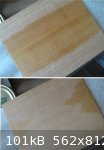
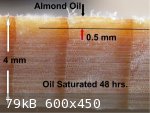
jdowning - 6-19-2012 at 12:09 PM
In the meantime, the test strip left soaking in Almond oil on both sides - wrapped in plastic for 48 hours - has been wiped free of surplus oil and
acoustic tested.
Average speed of sound is 5191 m/s or about 4% lower than for the oil free sample. For comparison, test piece #2 saturated with oil on one side for 24
hours had a measured speed of sound of 5281 m/s or about 2% less than the oil free sample supporting the proposal of only a limited depth of oil
absorption - about the same on both sides.
This gives a sound radiation coefficient of 10.1 compared to 10.3 for test#2 oiled on one side and 10.5 for the un-oiled test. So, as anticipated,
more oil absorbed equates to a reduction in the acoustic 'goodness' of a sound board - not good. However, if the oil had been left on the sound board
for 10 minutes in each case before wiping off (as would be normal practice) then any changes acoustically would be insignificant - based upon this
method of speed of sound testing longitudinal to the grain.
From the waveform, the estimated acoustic loss factor due to increased resistance to the sound wave and decreased amplitude/energy loss for each cycle
is about 0.014 compared to 0.013 for the non oiled test. This is a somewhat imperfect measurement (based upon a log. decrement calculation) due to the
complex waveform but is does indicate a slight increase in the internal damping of the wood. Again this is to be expected where any fluid has been
absorbed into the wood cellular structure - not good.
The quantity of oil absorbed into the test piece has been so small that any increase in density (as there must be - not good acoustically) cannot be
measured with the digital scale that I am using. Both a reduction in Sound Radiation Coefficient and increase in Acoustic Loss Factor represents what
is considered to be a reduction in the acoustic 'goodness' of a sound board material.
Note that the speed of sound measurement also provides a measure (Dynamic Modulus of Elasticity) of the longitudinal stiffness of wood. Here the DMOE
for the un-oiled test sample is 14.9 GPa whereas that for the oiled-both-sides sample is 13.9 GPa (the DMOE being proportional to the speed of sound
squared - i.e. SOS X SOS). In other words the oil absorbed into the wood has resulted in a reduction in stiffness of the wood measured along the
longitudinal axis.
High stiffness both longitudinally and across the grain radially (together with low density or soundboard 'weight'/volume) is considered to be the
hallmark of a good sound board wood. However, there is more to making a good sounding instrument than just stiffness and density of the sound board as
it all depends upon how well a luthier is able to make critical adjustments to the total assembled components. Volume of sound for example depends as
much on bowl volume, geometry, sound hole diameter and placement (not to mention bracing geometry!) as it does on the measured acoustic properties of
the sound board.
To complete this investigation the test sample will next be saturated with water on both sides - just to see what happens.
jdowning - 6-20-2012 at 10:02 AM
The test sample was flooded with water first on one side then on the other and left overnight to dry out. before acoustic testing.
What became immediately apparent is that on applying water to one side the test sample became bowed - curving away from the moistened face. This means
the the oil offered little or no resistance to the water being absorbed by the wood - the wood cells swelling as they readily absorbed the water on
one side so causing the test piece to bend longitudinally. The test piece became straight again on drying.
Acoustic testing of the dried out test piece showed no significant change from when saturated with oil on both sides.
The test piece was originally prepared by cutting a larger section of spruce down the middle to create two matching quarter sawn pieces - one of
thickness 2.5 mm being used for this current sequence of tests.
The remaining piece has now been prepared to a thickness of 1.5 mm and will be acoustically tested both free of oil and oiled on one side. It has been
previously demonstrated that the depth of penetration of the oil - when wiped on to one surface - is estimated to be less than about 0.3 mm. This
further test is to determine if this level of oil penetration, being proportionally greater than in the thicker specimen, has any significant effect
on speed of sound and internal damping. In this case the oil layer would occupy about 20% of the cross section area of the 1.5 mm thick specimen
compared to 12% in the case of the 2.5 mm thick specimen. A thickness of 1.5 mm is about the thinnest practical limit for a lute or oud sound board
and 2.5 mm is about the maximum upper limit.
It is not known if such a thin test piece will yield a clear frequency spectrum so this next trial will be of interest from that perspective alone.
jdowning - 6-21-2012 at 10:02 AM
The thinner 1.5 mm thick test piece produced good results with five clear harmonic peaks on the frequency spectrum analysis. Speed of sound un-oiled
was 5388 m/s - no different from that of the 2.5 mm thick test piece.
For the oiled case, speed of sound was 5366 m/s - so no significant change due to oiling giving a sound radiation coefficient R of 10.5.
From the waveforms, the estimated loss factor due to internal friction un-oiled was 0.010 whereas that for the oiled case was 0.012. So for the thin
1.5 mm sample the applied oil does cause a relative significant increase of about 20% in the damping of the sound vibrations (i.e. reduced sound board
resonance) whereas for the thicker 2.5 mm test piece there was no significant difference in the loss factor between the oiled and un-oiled cases.
So - what might be the consequences of applying a non drying vegetable oil to a sound board based upon these trials?
The oil is non drying - i.e. it will never solidify, ever.
If wiped on in the manner of a drying oil finish, it will only be absorbed into the first few wood cell layers of a sound board up to an estimated
depth of about 0.3 mm. This oil layer will cause increased internal damping of sound waves (reduced resonance) longitudinally and radially (the latter
has not been tested here) - the thinner the sound board the greater the effect. There may be some slight reduction in the Sound Radiation Coefficient
due to the oil layer increasing the sound board density - more so in thinner sound boards (but not measured in these tests).
Both a reduction in the Sound Radiation Coefficient and increase in the loss factor are considered to be detrimental to the 'acoustic goodness' of a
sound board material - particularly in the case of plucked instruments. However it is difficult to estimate how significant or otherwise (good or bad)
any such small changes to the sound board acoustic properties as a result of oiling may affect the acoustic performance of a completed instrument -
there being many critical factors in the design and fabrication of an instrument than just the acoustic goodness of the sound board material.
Also, over time the oil will attract dirt and grime. Furthermore contamination by oil of the wood cells on the sound board upper surface might
complicate future bridge and pick guard replacement or sound board inlay repairs.
So - all in all - I would agree with fernandraynaud that coating an oud (or lute) sound board with a non drying vegetable oil is not a good idea.
Now to remove the bottle of Almond oil from my workshop as it is very easy to contaminate wooden bench tops, wood stock and wooden components when
handling the stuff.
oudistcamp - 6-21-2012 at 11:39 AM
Thank you for the tests,results and conclusion.
I will let you know how the face looks, and what the oud sounds like, when I see it next month.
jdowning - 6-21-2012 at 04:24 PM
I forgot to add that non drying vegetable oil does not provide a barrier to the ingress of moisture to sound board wood - but then neither does a
drying oil, water vapour entering not through the oil layer but via the internal surfaces of the sound board that are normally left untreated.
Both moisture and high temperature in wood reduces speed of sound as well as increases the loss factor to the (temporary) detriment of the acoustic
performance of an instrument - a condition familiar to many who play oud or lute during the hot humid days of summer.


